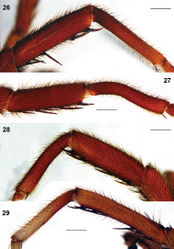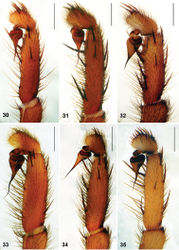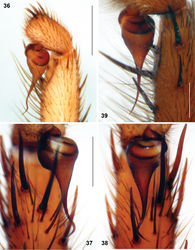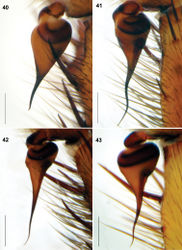Raveniola
| Notice: | This page is derived from the original publication listed below, whose author(s) should always be credited. Further contributors may edit and improve the content of this page and, consequently, need to be credited as well (see page history). Any assessment of factual correctness requires a careful review of the original article as well as of subsequent contributions.
If you are uncertain whether your planned contribution is correct or not, we suggest that you use the associated discussion page instead of editing the page directly. This page should be cited as follows (rationale):
Citation formats to copy and paste
BibTeX: @article{Zonstein2012ZooKeys211, RIS/ Endnote: TY - JOUR Wikipedia/ Citizendium: <ref name="Zonstein2012ZooKeys211">{{Citation See also the citation download page at the journal. |
Name
Raveniola Zonstein, 1987 – Wikispecies link – Pensoft Profile
- Raveniola Zonstein 1987[1]: 1014, type species Brachythele virgata Simon, 1891, by the original designation.
Diagnosis
By retroventral position of the male mating spur on tibia I, Raveniola differs essentially from the majority of the Holarctic and Asian nemesiid genera: from Mediterranean Nemesia Audouin, 1826, Iberesia Decae & Cardoso, 2006 and Brachythele Ausserer, 1871 as well as from the Nearctic Calisoga Chamberlin, 1937 and from Asian Atmethochilus Simon, 1887 and Damarchus Thorell, 1891. Males in all these genera possess mating spurs located on the process ventrally or prolaterally. In addition, in the two latter genera males have paired tarsal claws provided with a single S-shaped tooth row instead of the biserial dentition typical for male nemesiids.
Within the rest of this group of genera, in which males are also known to possess the retrolateral or retroventral megaspines on tibia I, Raveniola can be distinguished from Central American Mexentypesa Raven, 1987 by having the unpaired tarsal claw (absent in the latter genus) and integral tarsi (pseudosegmented in Mexentypesa); from African Hermacha Simon, 1889, Entypesa Simon, 1902, Lepthercus Purcell, 1902 and Pionothele Purcell, 1902 – by much smaller PMS (from first three of them) or longer apical segment of PLS (domed in Pionothele). Moreover, males of Raveniola differ from males of all the above-mentioned genera by their elongate, cylindrical and strongly spinose palpal tibiae. The congeneric females have no unique distinctive characters.
East-Asian Sinopesa Raven & Schwendinger, 1995 is the only genus that has been found to share with Raveniola the above-listed definitive features. These partially sympatric genera differ from each other by the characters shown in the table in the Discussion below.
Description
Medium-sized to large nemesiids with carapace 4–14 mm long. Carapace hirsute. Eye tubercle low to moderately developed. Chelicerae in most species without rastellum. Maxillae rectangular with few to numerous cuspules. Serrula not evident. Labium twice wider than long with no cuspules. Paired sternal sigillae small round submarginal to marginal. Leg formula 4123 or 1423. Metatarsal preening combs absent. Leg tarsi integral (not cracked or pseudosegmented), aspinose in most species. In males scopula on tarsi I always entire; tarsi II with entire or narrowly divided scopula; tarsi III and IV with widely divided scopula or without it; conspecific females with weaker scopula on posterior tarsi. Paired tarsal claws biserially toothed both in males and females; claw apex long and moderately curved. Unpaired tarsal claw small and sharply bent. Males: intercheliceral tumescence if present located ventrally; palpal tibia ±long, spinose; cymbium rather short with or without spines; tibia I with 2(3) sequential megaspines. Females: each paired spermatheca with 2–3 individual diverticulae. PMS small to absent. PLS: apical segment triangle to digitiform.
Distribution, habitats and ecology
Over 20 species are currently known in the south Palearctic, from Turkey to China (see Platnick 2012[2]). The spiders inhabit different types of forest and steppe biotopes, subalpine and alpine meadows from seashore up to 4300 m above sea level. They can occur under rocks and logs, or inhabit abandoned rodent burrows, or crevices. Adult females can be found building simple burrows 10–20 cm (in Raveniola ferghanensis - up to 40–50 cm) depth with weak silk lining and open entrance.
Unfortunately, we have no direct label data shoving peculiarities in the habitats and ecology of Chinese species of Raveniola. The only male of Raveniola yunnanensis sp. n.was found under the rock in the mixed mountainous broad-leaved forest (I. Kabak, personal communication). The representatives of Raveniola montana sp. n., Raveniola shangrila sp. n. and Raveniola songi sp. n. were collected with pitfall traps together with highland ants Myrmica pleiorhytida Radchenko & Elmes, 2009 (Hymenoptera, Formicidae) by the same collectors and in the same biotope. The latter species was noted inhabiting mountainous meadows (see Radchenko and Elmes 2010[3], p. 219).
Key to Chinese Raveniola
Females of Raveniola guangxi, Raveniola shangrila sp. n., Raveniola songi sp. n. and Raveniola yunnanensis sp. n. are unknown.
Taxon Treatment
- Zonstein, S; Marusik, Y; 2012: A review of the genus Raveniola (Araneae, Nemesiidae) in China, with notes on allied genera and description of four new species from Yunnan ZooKeys, 211: 71-99. doi
Images
|
Other References
- ↑ Zonstein S (1987) A new genus of mygalomorph spiders of the subfamily Nemesiinae (Aranei, Nemesiidae) in the Palearctic fauna. Zoologicheskiy Zhurnal 66 (7): 1013-1019. [in Russian]
- ↑ Platnick N (2012) The world spider catalog, version 13.0. American Museum of Natural History. http://research.amnh.org/entomology/spiders/catalog/index.html
- ↑ Radchenko A, Elmes G (2010) Myrmica ants (Hymenoptera, Formicidae) of the Old World. Fauna Mundi 3: 1-789.
- ↑ Hu J, Li A (1987) The spiders collected from the fields and the forests of Xizang Autonomous Region, China. Agricultural Insects, Spiders, Plant Diseases and Weeds of Xizang 1: 315-392. [in Chinese]




![Figures 47–50. Raveniola, bulbus (49, holotype male, ventral view) and spermathecae (47, 48, 50, conspecific/paratype females, ventral view): 47 Raveniola hebeinica 48 montana sp. n. 49, 50 Raveniola xizangensis (from Hu and Li (1987)[4], modified); scale bar = 0.25 mm.](https://species-id.net/o/thumb.php?f=ZooKeys-211-071-g013.jpg&width=176)